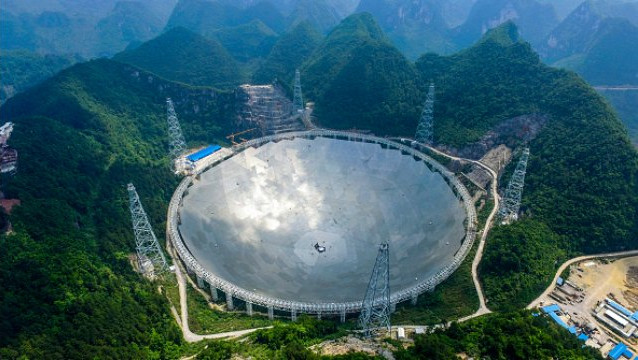The world's largest alien hunting telescope was born
China officially completes the world's largest radio telescope, which specializes in hunting for signs of alien life in the distant universe after finishing the final reflector.
Telescope 500m wide aperture (FAST ) includes 4,450 reflectors with a diameter of 457m, equivalent to 30 football fields, according to Xinhua.
About 300 people witnessed the process of installing the last triangular mirror on the reflecting surface of the glass in the southwestern county of Pingtang district, China on July 2. The project was first published in 1994. Installation began in March 2011 at a cost of US $ 105 million and completed two months ahead of schedule.

FAST, the world's largest radio telescope, was officially completed.(Photo: Scoopnest).
In 2009, all 9,110 residents living in the surrounding area were relocated to four other settlements with government grants to create an ideal electromagnetic wave environment for active telescopes. Each household is compensated for 1,800 USD.
Within a radius of 4.8 km around a telescope, there are no residents. Three hills around the basin form an equilateral triangle. Before the birth of FAST, the world's largest aperture telescope was located at the Arecibo Observatory in Puerto Rico, 300 meters in diameter.
"As the world's largest aperture telescope is located in an extremely quiet area, the influence of FAST on astronomical research will be immense and it certainly leads to revolution in many areas of science. Nature, " Nan Rendong, the head of the FAST project, shared.
FAST will allow astronomers to survey hydrogen gas in many distant galaxies and detect faint bright quasars, fast-rotating neutron stars with high magnetic fields, emitting electromagnetic radiation from the field.
The project also aims to study many strange objects to better understand the origin of the universe and to search for alien life, according to Zheng Xiaonian, deputy director of the National Observatory of the Chinese Academy of Sciences. In the next 2-3 years, scientists can detect amino acids, important life-forming materials, in the universe.
- China announced plans to 'hunt' aliens with the largest telescope
- Telescope 'hunt' aliens damaged after the storm
- China's 'alien hunting' glasses had the first big result
- The most ideal places in the world to
- China relocated more than 9,000 people to hunt people out of space
- Discovering many cosmic mysteries, people yearn to find new worlds
- FAST telescope is being threatened by Chinese people
- This is what NASA will use to hunt aliens
- NASA's 'powerful arm' alien hunting disappeared mysteriously
- China hunts aliens with giant telescopes
- New alien hunting tool with high sensitivity
- Commencement of the world's largest telescope project in Chile
 Norway built the world's tallest wooden tower
Norway built the world's tallest wooden tower Kremlin
Kremlin Ashurbanipal: The oldest royal library in the world
Ashurbanipal: The oldest royal library in the world Decoding the thousand-year construction of Qin Shihuang shocked the world
Decoding the thousand-year construction of Qin Shihuang shocked the world